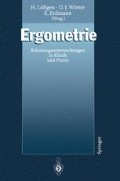Zusammenfassung
Ergometrische Untersuchungen können im Kindesalter einerseits dazu dienen, den Leistungsstand von Gesunden zu objektivieren und zur Beurteilung der sportlichen Belastbarkeit beizutragen [9, 10, 20]. Andererseits liefern sie bei einer ganzen Reihe von Erkrankungen wertvolle Informationen. Bei Kindern mit obstruktiven Lungenerkrankungen ergibt die Belastungsreaktion einen Hinweis auf das Ausmaß der Ventilationsstörung. Die Hypoxämie ist hierbei umso ausgeprägter, je mehr die Belüftungs-Durchblutungs-Verhältnisse in verschiedenen Lungenpartien gestört sind. Die Hyperventilation ist umso stärker ausgeprägt, je mehr der physiologische Totraum vergrößert ist [2]. Bei Patienten mit Mukoviszidose ist die kardiopulmonale Leistungsfähigkeit häufig durch die maximale Ventilation begrenzt, die bei Herzgesunden niemals ein limitierender Faktor ist. Bei Kindern mit Bronchialasthma wird die Bronchokonstriktion häufig durch körperliche Aktivität getriggert, am ehesten durch kontinuierliches Laufen über einen Zeitraum von 6 min bei einer Intensität von etwa 70 % der maximalen Sauerstoffaufnahme bzw. einer Herzfrequenz von etwa 180/min [8]. Belastungstests können aber bei dieser Erkrankung auch zur medikamentösen Eintellung und zur Ermittlung günstiger Belastungsformen herangezogen werden.
Access this chapter
Tax calculation will be finalised at checkout
Purchases are for personal use only
Preview
Unable to display preview. Download preview PDF.
Literatur
Bar-Or O, Inbar O, Spira R (1976) Physiological effects of a sports rehabilitation program on cerebral palsied and post-poliomyelitic adolescents. Med Sci Sports 8: 157–161
Coates AL, Boyce P, Muller D, Mearns M, Godfrey S (1980) The role of nutritional status, airways obstruction, hypoxia, and abnormalities in serum lipid composition in limiting exercise tolerance in children with cystic fibrosis. Acta Paediatr Scand 69: 353–358
Cumming G, Everatt R, Hastman L (1987) The Bruce treatmill test in children: Normal values in a clinic population. Am J Cardiol 41: 69–75
Ekblom B, Astrand P-0, Saltin B, Stenberg J, Wallström B (1968) Effect of training on circulatory response to exercise. J Appl Physiol 24: 518–528
Eriksson BO, Grimby G, Saltin B (1971) Cardiac output and arterial blood gases during exercise in pubertal boys. J Appl Physiol 31: 348–352
Gildein HP, Kaufmehl K, Last M, Leititis J, Wildberg A, Mocellin R (1993) Oxygen deficit and blood lactate in prepubertal boys during exercise above the anaerobic threshold. Eur J Pediatr 152: 226–231
Gildein HP, Kaufmehl K, Mocellin R (1994) Oxygen uptake transient kinetics during constant-load exercise in children after operations of ventricular septal defect, tetralogy of Fallot, transposition of the great arteries or tricuspid valve atresia. Am J Cardiol 74: 166–169
Godfrey S (1988) Exercise induced asthma. In: Bierman CW, Pearlman DS (eds) Allergic Diseases from infancy to adulthood, end edition. Saunders, Philadelphia London Toronto, pp 597–606
Lentner C (Hrsg) (1990) Geigy scientific tables, vol V: Heart and circulation. Ciba-Geigy, Basel
Löllgen H (1990) Kardiopulmonale Funktionsdiagnostik, 2. Aufl. Ciba-Geigy, Wehr
u. Ludvigsson J (1980) Physical exercise in relation to degree of metabolic control in juvenile diabetes. Acta Paediatr Scand Suppl 283: 45–49
Meredith HV (1964) Percentiles for weight and height. In: Nelson WE (Hrsg) Textbook of Pediatrics. Saunders, Philadelphia London Toronto, p 50–58
Mocellin R (1986) Exercise testing in children with congenital heart disease. Pediatrician 13: 18–25
Mocellin R, Bastanier C (1976) Zur Frage der Zuverlässigkeit der W„o als Maß der körperlichen Leistungsfähigkeit bei der Beurteilung von Kindern mit Herzfehlern. Eur J Pediatr 122: 223–239
Neary PJ, McDougall JD, Bachus R, Wenger HA (1985) The relationship between lactate and ventilatory thresholds: Coincidental or cause and effect. Eur J Appl Physiol 36: 367–373
Reybrouck T, Weymans M, Stijns H, Knops H, Hauwaert L van der (1985) Ventilatory anaerobic threshold in healthy children. Age and sex differences. Eur J Appl Physiol 54: 278–284
Rotstein A, Dotan R, Bar-Or O, Tenenbaum G (1986) Effect of training on anaerobic threshold, maximal aerobic power and anaerobic performance of preadolescent boys. Int J Sports Med 7: 282–286
Rutenfranz J (1964) Entwicklung und Beurteilung der körperlichen Leistungsfähigkeit bei Kindern und Jugendlichen. Karger, Basel, S 24–29
Voigt B (1988) Anforderungen an Fußkurbelergometer für Kinder. Biomed Technik 33: 126–130
Wilmore JH, Winston M (eds) (1994) Guidelines for exercise testing in the pediatric age group. Circulation 90: 2166–2179
Zanconato S, Baraldi E, Santuz P, Rigon F,Vido L, Da Dalt L, Zacchello F (1989) Gas exchange during exercise in obese children. Eur J Peditr 148: 614–617
Editor information
Editors and Affiliations
Rights and permissions
Copyright information
© 1995 Springer-Verlag Berlin Heidelberg
About this chapter
Cite this chapter
Mocellin, R., Gildein, P. (1995). Ergometrie in der Pädiatrie. In: Löllgen, H., Winter, U.J., Erdmann, E. (eds) Ergometrie. Springer, Berlin, Heidelberg. https://doi.org/10.1007/978-3-662-07084-0_24
Download citation
DOI: https://doi.org/10.1007/978-3-662-07084-0_24
Publisher Name: Springer, Berlin, Heidelberg
Print ISBN: 978-3-540-58587-9
Online ISBN: 978-3-662-07084-0
eBook Packages: Springer Book Archive

